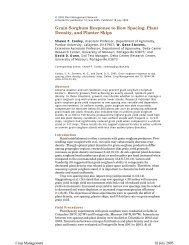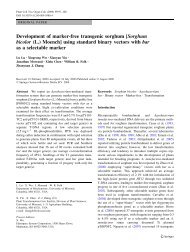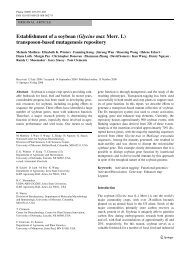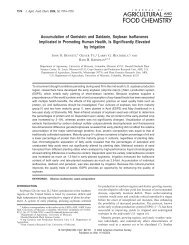Assessment of Indigenous Nepalese Soybean as a Potential ...
Assessment of Indigenous Nepalese Soybean as a Potential ...
Assessment of Indigenous Nepalese Soybean as a Potential ...
You also want an ePaper? Increase the reach of your titles
YUMPU automatically turns print PDFs into web optimized ePapers that Google loves.
5490 J. Agric. Food Chem., Vol. 54, No. 15, 2006 Krishnan et al.<br />
Asia holds the largest variety <strong>of</strong> soybean cultivars (12, 13).<br />
The immense geographical area <strong>of</strong> the continent with a variety<br />
<strong>of</strong> growing conditions and selection b<strong>as</strong>ed on various food type<br />
preferences h<strong>as</strong> given rise to thousands <strong>of</strong> phenotypically diverse<br />
landraces (14). A study <strong>of</strong> over 20000 Chinese soybean<br />
accessions, excluding those bred in the p<strong>as</strong>t 50 years, h<strong>as</strong><br />
provided evidence <strong>of</strong> marked germpl<strong>as</strong>m diversity (12). Similar<br />
evaluations <strong>of</strong> the genetic diversity among soybean germpl<strong>as</strong>ms<br />
in other countries have also been performed (15-17). Genetic<br />
diversity observed between germpl<strong>as</strong>ms found in the northern<br />
and southern growing regions <strong>of</strong> the United States h<strong>as</strong> been<br />
<strong>as</strong>cribed to their different ancestral backgrounds (1, 9, 18-20).<br />
In Japan, the diversity in the soybean germpl<strong>as</strong>m h<strong>as</strong> been<br />
attributed to continual introduction <strong>of</strong> domestic landraces and<br />
plant introductions into the breeding program (21, 22). Because<br />
significant genetic diversity exists between Chinese, Japanese,<br />
and Korean germpl<strong>as</strong>ms, each h<strong>as</strong> the potential for improving<br />
U.S. cultivars (11, 17).<br />
At present 15000 accessions are available in the USDA<br />
soybean germpl<strong>as</strong>m collection, most <strong>of</strong> which do not appear in<br />
pedigrees <strong>of</strong> U.S. cultivars (23). Introduction <strong>of</strong> exotic germpl<strong>as</strong>m<br />
holds promise for expanding the genetic diversity <strong>of</strong> North<br />
American cultivars, facilitating the continued improvement in<br />
yield and enhancing the content <strong>of</strong> desired seed components<br />
(24). These accessions are being scrutinized to identify unique<br />
genes that hold potential for improving U.S. soybean yield and<br />
seed characteristics. Incorporation <strong>of</strong> these exotic germpl<strong>as</strong>ms,<br />
however, must be done in a calculated manner to maximize the<br />
desired effect <strong>of</strong> the combined genetic material and to minimize<br />
introduction <strong>of</strong> deleterious traits (25-28). Several plant introduction<br />
lines (PI) from China have been shown to contain high<br />
levels (>50%) <strong>of</strong> protein (12). These PIs are currently utilized<br />
in the breeding programs to incorporate the high protein trait<br />
in North American commercial cultivars. To expand the genetic<br />
diversity <strong>of</strong> North American cultivars, it would be desirable to<br />
utilize soybean germpl<strong>as</strong>m from other regions <strong>of</strong> the world.<br />
Toward this goal, we have examined the potential <strong>of</strong> some<br />
soybean cultivars from Nepal <strong>as</strong> a germpl<strong>as</strong>m resource for<br />
improvement <strong>of</strong> North American cultivars. As a first step in<br />
this direction, we have carried out proteonomic and molecular<br />
studies on the seed storage proteins <strong>of</strong> soybean cultivars from<br />
Nepal.<br />
MATERIALS AND METHODS<br />
Plant Materials. <strong>Soybean</strong> cultivars ‘Sathia’, ‘Seti’, ‘Kavre’, and<br />
‘Soida Chiny’ indigenous to various regions <strong>of</strong> Nepal (all belonging<br />
to maturity group V) and the North American cultivar ‘Williams 82’<br />
(maturity group III) were grown during the 2004 and 2005 se<strong>as</strong>ons at<br />
the University <strong>of</strong> Missouri Bradford Research Center near Columbia,<br />
MO.<br />
Amino Acid Analysis. Four replicates <strong>of</strong> dry seed powder from each<br />
cultivar representing both growing se<strong>as</strong>ons were hydrolyzed under<br />
nitrogen at 155 °C for 16 h in 6 N HCl. The content <strong>of</strong> the sulfur<br />
amino acids w<strong>as</strong> determined separately from samples, which had been<br />
pretreated with performic acid prior to standard acid hydrolysis.<br />
Tryptophan content w<strong>as</strong> analyzed by enzymatic hydrolysis <strong>of</strong> seed<br />
protein followed by colorimetric determination. Amino acids were<br />
separated on a high-performance cation-exchange resin column installed<br />
in the Beckman 6300 Amino Acid Analyzer (Beckman Instruments,<br />
Fullerton, CA). Quantification w<strong>as</strong> performed colormetrically using the<br />
postcolumn ninhydrin reaction detection system.<br />
Modified Trichloroacetic Acid (TCA)/Acetone/Urea Extraction<br />
and Solubilization <strong>of</strong> Seed Protein for Two-Dimensional (2-D)<br />
Polyacrylamide Gel Electrophoresis (PAGE). One hundred milligrams<br />
<strong>of</strong> replicated samples from each cultivar and year <strong>of</strong> study w<strong>as</strong><br />
extracted with 2 mL <strong>of</strong> 10% TCA in acetone (w/v) containing 0.07%<br />
2-mercaptoethanol (w/v) <strong>as</strong> described (29). Precipitated proteins were<br />
recovered by centrifugation and w<strong>as</strong>hed three times in acetone<br />
containing 0.07% 2-mercaptoethanol (w/v). The pellet w<strong>as</strong> dried,<br />
resuspended in 1 mL <strong>of</strong> lysis buffer composed <strong>of</strong> 9 M urea, 1% CHAPS<br />
(w/v) 1% ampholytes (w/v), pH 3-10, and 1% DTT (w/v), and then<br />
sonicated. After centrifugation (20800g, 20 min, 4 °C), aliquots <strong>of</strong> the<br />
supernatant were analyzed by 2-D PAGE.<br />
Isoelectric focusing (IEF) w<strong>as</strong> performed using 13 cm IPG strips<br />
(pH 3-10, 4-7, or 6-11) in the IPGphor System (Amersham<br />
Biosciences, Piscataway, NJ). A 100 µg sample <strong>of</strong> protein w<strong>as</strong> loaded<br />
onto the strips by active rehydration in 250 µL <strong>of</strong> buffer containing 8<br />
M urea, 2% CHAPS (w/v), 0.5% ampholytes, and 0.002% bromphenol<br />
blue. Conditions for IEF were <strong>as</strong> described for 2-d PAGE. Electrophoretic<br />
separation according to m<strong>as</strong>s w<strong>as</strong> performed on a 13.5% SDS-<br />
PAGE gel (30). The gels were fixed overnight in a solution <strong>of</strong> 50%<br />
ethanol (v/v) and 3% phosphoric acid. After a distilled water w<strong>as</strong>h,<br />
the gels were prestained for 1hin34%methanol, 17% ammonium<br />
sulfate, and 3% phosphoric acid and then stained in 0.066% Coom<strong>as</strong>sie<br />
blue G250 (w/v). Until analysis, the gels were stored in 20% ammonium<br />
sulfate.<br />
Image Analysis. Scanning l<strong>as</strong>er densitometry in conjunction with<br />
analysis s<strong>of</strong>tware (Personal Densitometer SI, ImageQuant s<strong>of</strong>tware,<br />
Amersham Biosciences) w<strong>as</strong> used to quantify the proteins resolved by<br />
2-D PAGE. S<strong>of</strong>tware algorithms were used to calculate spot volume,<br />
pixel area, mean pixel intensity, standard deviation, and background<br />
values.<br />
In-Gel Digestion <strong>of</strong> Protein Spots. After excision from the gel,<br />
protein spots selected for m<strong>as</strong>s spectrographic analysis were w<strong>as</strong>hed<br />
in distilled water and then destained in a 50% solution <strong>of</strong> acetonitrile<br />
(v/v) containing 25 mM ammonium bicarbonate. After a 100%<br />
acetonitrile w<strong>as</strong>h, the proteins contained in the gel spots were subjected<br />
to digestion using 20 µL (10 µg/mL) <strong>of</strong> modified porcine trypsin in 25<br />
mM ammonium bicarbonate (Promega, Madison, WI). The fragmented<br />
proteins were sonicated in 50% acetonitrile/5% trifluoroacetic acid<br />
(TFA) (v/v), dried, and then reconstituted in 50% acetonitrile/0.1% TFA<br />
(v/v).<br />
Matrix-Assisted L<strong>as</strong>er Desorption Ionization Time-<strong>of</strong>-Flight<br />
M<strong>as</strong>s Spectrometry (MALDI-TOF-MS) Analysis <strong>of</strong> Trypsin-<br />
Digested Proteins. Peptides resulting from tryptic digestion <strong>of</strong> soybean<br />
seed proteins were analyzed by m<strong>as</strong>s spectroscopy (Voyager DE-STR<br />
MALDI-TOF, Applied Biosystems, Framingham, MA). The peptides<br />
were cocrystallized with the matrix material R-cyano-4-hydroxycinnamic<br />
acid. A 337 nm nitrogen l<strong>as</strong>er operating at 20 Hz w<strong>as</strong> used in<br />
sample ionization. Trypsin autolysis peaks <strong>of</strong> charge m<strong>as</strong>s ratios 842.51<br />
and 2211.10 served <strong>as</strong> internal standards.<br />
Liquid Chromatography-M<strong>as</strong>s spectrometry (LC-MS) Analysis.<br />
Peaks that were not identified by MALDI-TOF were analyzed using<br />
an ion trap m<strong>as</strong>s spectrometer (Finnigan LCQ Deca XP Plus, Thermo<br />
Electron Corp., Waltham, MA). Prior to m<strong>as</strong>s analysis, peptides were<br />
separated by liquid chromatography on a reverse ph<strong>as</strong>e column with a<br />
5-60% gradient <strong>of</strong> acetonitrile/water containing 0.1% formic acid.<br />
When two MS/MS spectra <strong>of</strong> an ion were acquired, dynamic exclusion<br />
circumvented continuous analysis. Initial processing <strong>of</strong> the data w<strong>as</strong><br />
done using Sequest (University <strong>of</strong> W<strong>as</strong>hington, Seattle, WA). The<br />
multiple Sequest DTA files were then concatenated into a single M<strong>as</strong>cot<br />
file using merge pl. script (Matrix Science, Boston, MA).<br />
Data Interpretation. Using M<strong>as</strong>cot, the empirically determined<br />
m<strong>as</strong>s-to-charge ratios <strong>of</strong> peptides were compared with those derived<br />
from peptides <strong>of</strong> known sequences listed in the National Center for<br />
Biotechnology Information nonredundant datab<strong>as</strong>e. M<strong>as</strong>cot search<br />
parameters <strong>of</strong> MALDI-TOF and MS/MS generated data were set forth<br />
previously (29). At le<strong>as</strong>t two unique peptides with one or more having<br />
a significant ion score were required for positive identification by<br />
tandem m<strong>as</strong>s spectroscopy. Positive identification by MALDI-TOF<br />
required that the protein meet or exceed the minimum significant score.<br />
Southern Hybridization. Total genomic DNA w<strong>as</strong> isolated from<br />
leaf tissue <strong>of</strong> the soybean cultivars using the cetyltrimethylammonium<br />
bromide (CTAB) method (31). Genomic DNA (8 µg) w<strong>as</strong> digested<br />
overnight at 37 °C with EcoRI. Restricted DNA w<strong>as</strong> electrophoretically<br />
separated on an 0.8% agarose gel and then transferred to a nylon<br />
membrane by capillary action using 0.04 M NaOH <strong>as</strong> the carrier. DNA








